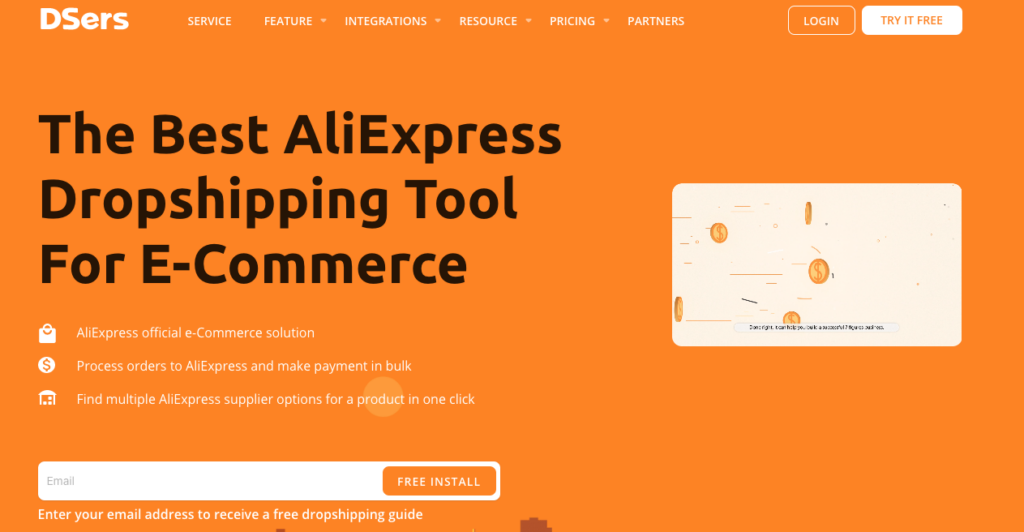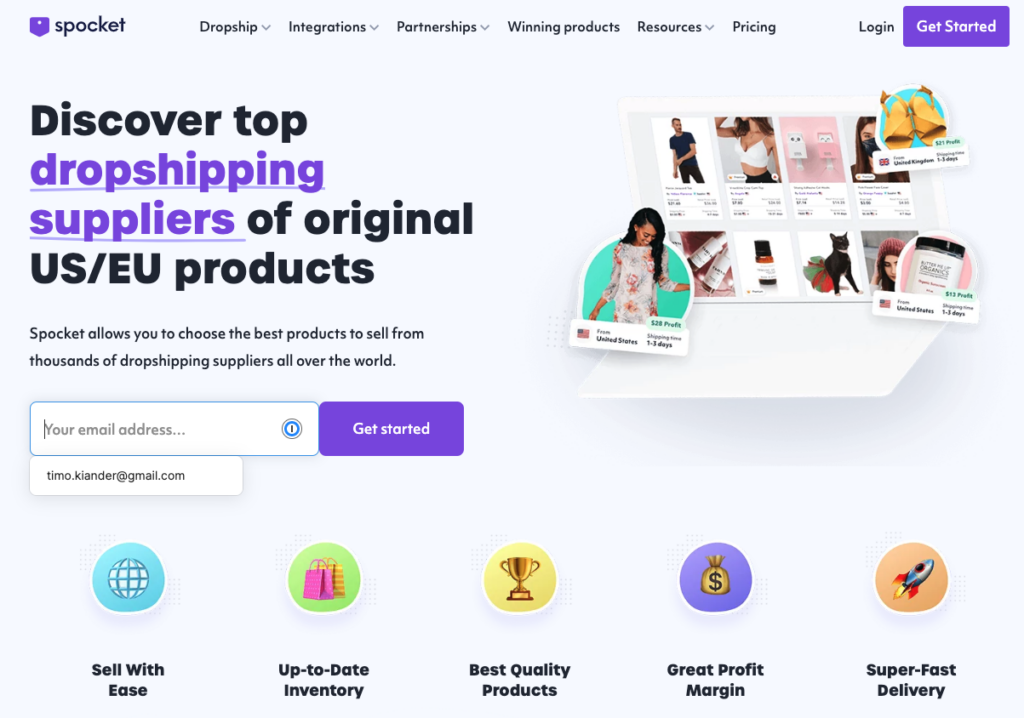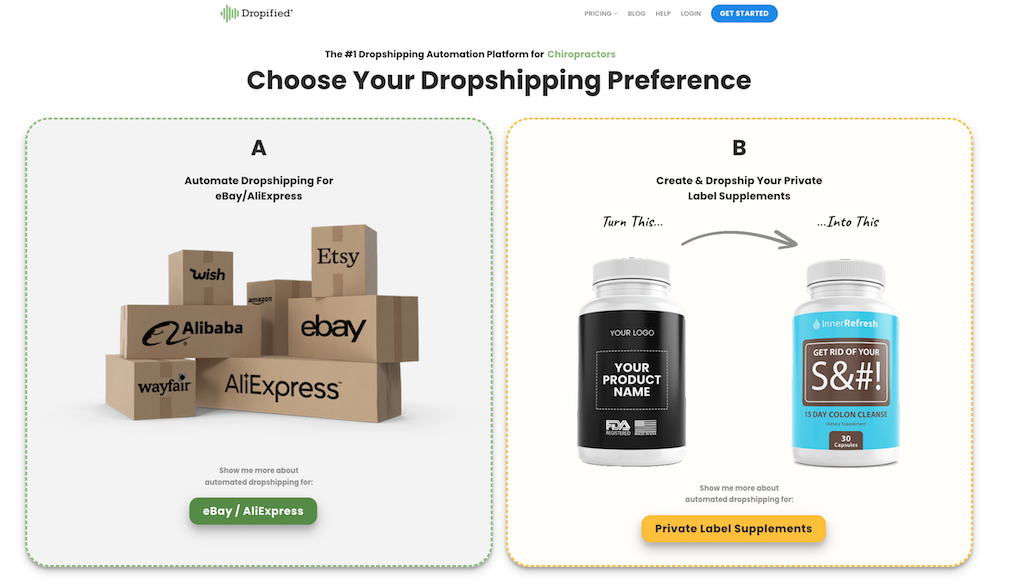Dropshipping 101: The Retail Fulfillment Method for 2024 and Beyond

Whether you’re just opening your first eCommerce store or you’re an established merchant, there are certain decisions you need to make about your business. One such decision is how you will manage inventory and fulfill customer orders.
In this post, we’ll introduce one retail fulfillment method that is taking the eCommerce industry by storm: dropshipping. The article will look at how it compares to other methods and the pros and cons of its use.
If you choose this route, we’ll also share three dropshipping tools you can use in your online retail business.
Let’s get started!
What is Dropshipping?
In simplest terms, dropshipping is a retail fulfillment method that enables companies to sell products without physical inventory management.
Instead, inventory management tasks, including storage, fulfillment, and shipping, are outsourced to a dropshipping supplier that ships products to customers on behalf of the retailer.
This method contrasts with other eCommerce business models, and here’s how.
In-House Fulfillment
In-house fulfillment is the traditional fulfillment method in which merchants fulfill products themselves. They handle all tasks associated with storage and fulfillment, including storage, inventory tracking, packaging, and shipping.
Small businesses often use this approach, though large companies can also use this method if they have enough storage space and the money to hire a fulfillment crew.
Fulfillment Centers
A fulfillment center is a company that stores and manages inventory on behalf of retailers. And while this may seem similar to dropshipping, there is a major difference: product origin.
Dropshipping involves products created by manufacturers or wholesalers. The retailers simply facilitate the sale of these products.
On the other hand, fulfillment centers will store goods made by retailers or a manufacturer that the retailer hired independently of the fulfillment center.
This method is often used by small-to-medium businesses whose inventory and number of daily orders have outgrown their current business setup.
👍👎 The Pros and Cons of Dropshipping
As with any eCommerce method, there are pros and cons to dropshipping. Let’s take a look.
Pro 1: No Startup Costs
You will be expected to purchase materials or inventory with the traditional eCommerce methods mentioned above. Beyond that, you will also need to pay for inventory storage and perhaps even an inventory management team.
But with dropshipping, there are no startup costs involved.
Dropshipping enables you to offer an expansive product line without purchasing it upfront. That’s because dropshipping retailers only pay for the product’s wholesale price after a sale.
The product cost (and other costs, such as shipping and handling) will be subtracted from your gross profits after each sale or on a predetermined basis (such as weekly or monthly).
Pro 2: Little to No Risk
We mentioned above that dropshipping means you don’t have to purchase inventory upfront. That’s great news for your wallet, but it has one more benefit: little to no personal and business risk.
What does this mean exactly?
Traditional retailers warehouse their inventory or pay someone else (such as a manufacturer) to do it.
Once the stock is in their hands, they’re 100 percent responsible for all damages and losses. So, the retailer must take the loss, whether there’s flooding, an electrical fire, or theft. This risk extends further to their transport and shipping responsibilities, from which damage or loss becomes more of a possibility.
With dropshipping, things are different. They don’t have to worry about damage or loss within the warehouse, and the dropshipping provider will often cover loss during shipping.
The benefits of this are apparent, but this also means you can offer your customers a more extensive array of products without worrying about the additional responsibility associated with them.
Pro 3: Almost Limitless Scalability
The low risk associated with dropshipping gives your business significant flexibility and, even more importantly, almost limitless scalability.
To be scalable is to increase or decrease the number of products you offer. While sometimes you want to decrease product quantity, it’s more likely that growth will be your focus. And that’s fine when you choose an eCommerce model like dropshipping.
Dropshipping enables you to grow your business and easily sell dozens, hundreds, or even thousands of different products.
You don’t have to worry about cost or warehousing. You also don’t have to concern yourself with other business responsibilities often associated with growth, such as hiring more employees or moving into a larger retail space.
With dropshipping, you can decrease and increase your offerings whenever you’d like.
Con 1: Low-Profit Margins
Perhaps the greatest con to dropshipping is that many eCommerce retailers shy away from it because of the low-profit margins.
Dropshipping doesn’t give you much choice over product price. Many prices are automatically set and cannot be changed at all. And even further, the manufacturer sets the cost of products (i.e., what you will pay).
Con 2: Less Control Over the Process
For some, the fact that dropshipping means you have no part in the manufacturing, storing, and shipping of products is a major positive. But this does mean you have very little control, if any, over the process.
You can choose your dropshipping company, which means you can select the one that gives you the most control possible. However, there will always be parts in which you have no say.
For example, some dropshippers enable you to utilize branded packaging and/or invoices. You can also choose your shipping provider, in many cases. However, other companies may only allow their packaging use and may have a minimal list of shipping providers.
You have to determine if the benefits – no startup costs, low risk, and scalability – are worth the loss of control.
3 Dropshipping Tools to Use for Your Business
With the increasing popularity of dropshipping, there is an abundance of tools to choose from. Here are just a few to consider.
01. Shopify + DSers

If you haven’t heard of Shopify, you’re in for a treat!
Shopify is an eCommerce platform that enables you to easily create a storefront. It’s one of the top platforms in the industry, and with good reason.
It has all the features you’d need to start and run a successful eCommerce shop and an extensive collection of apps to expand those features.
One such app? DSers.
DSers is a dropshipping application that enables you to browse products available in AliExpress and add them to your Shopify store in minutes. These products include everything from apparel to technology.
Best of all, DSers offers automatic order fulfillment. So once an order is placed on your website, the request is sent directly to your supplier to prepare and ship it.
02. Shopify + Spocket

If DSers isn’t your cup of tea, then Spocket may be what you’re looking for.
The app offers many valuable features, including a wide range of products, branded invoicing, and access to higher-quality products.
However, there is one area in which Spocket stands out: bulk import. It enables you to grab products from any collection you like from AliExpress with the AliScraper Chrome extension.
Spocket also offers faster shipping times, so it’s certainly an option to consider.
Are you not on Shopify but still interested in the features offered by Spocket? No worries, because Spocket can be used on WooCommerce, too!
03. WooCommerce + Dropified

Shopify is perhaps the most popular eCommerce platform, but it’s not the only solid one. Other options, such as WooCommerce, exist with very similar features.
WooCommerce is an eCommerce software that works seamlessly alongside your self-hosted WordPress site. It works like Shopify, enabling you to sell products on your website and expand the software’s offerings with extensions.
One such extension is Dropified.
Dropified is a dropshipping extension that enables you to import products to your shop. It includes automatic order fulfillment and management options, even selling on the Facebook Marketplace.
You can start with a free plan to see if it’s a good fit for you.
FAQ
Dropshipping on Amazon is allowed if you follow their dropshipping policies.
For instance, you should clearly indicate (in invoicing, packaging slips, external packaging, and other items included with the product) that you are the goods seller or responsible for accepting and processing returns.
Yes, dropshipping is a legit business model.
Big eCommerce platforms like Shopify or WooCommerce even have enabled dropshipping on their platform with their apps.
Remember this: As with any accurate business model, dropshipping doesn’t provide overnight success. It requires a lot of work and long-term commitment to succeed.
Not at all. In fact, it’s easier to start with a cloud-based platform rather than building your dropshipping website from scratch.
Many platforms offer dropshipping services, and the biggest ones include Shopify and WooCommerce. They have already done all the hard work for you, so you can focus on things like stellar customer support, bringing quality products to your store, or improving your site’s SEO.
Dropshipping is a unique retail fulfillment method that is a perfect fit for the right type of retailer.
Those who want to sell their products or who want significant control over the process would not benefit from its use. However, those who wish to expand their current product offerings with low costs and little risk may be the best choice.
Do you have questions about how to implement dropshipping within your business? Let us know in the comments section below!

Leave a Reply